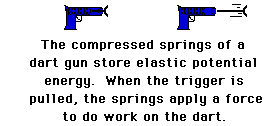| Return to First Quarter Page
Work and Energy
| WORK |
| When a force acts upon an object to cause a displacement of the object, it is said that work was done upon the object. There are three key ingredients to work - force, displacement, and cause. In order for a force to qualify as having done work on an object, there must be a displacement and the force must cause the displacement. There are several good examples of work which can be observed in everyday life - a horse pulling a plow through the field, a father pushing a grocery cart down the aisle of a grocery store, a freshman lifting a backpack full of books upon her shoulder, a weightlifter lifting a barbell above his head, an Olympian launching the shot-put, etc. In each case described here there is a force exerted upon an object to cause that object to be displaced. |
| |
| Mathematically, work can be expressed by the following equation. |
| |
| The net work = net force x displacement x cosine of angle between them. |
| |
| The use of cosine adjusts the force so that it is only counting the amount of force that is in the same direction as the displacement. |
| |
 If you were to push your cafeteria tray at a constant speed across a table its acceleration is zero and therefore its force is zero. This means no work is being done. The same can be said by lifting your tray and walking across the room and then setting them down at the same height they were sitting previously. Since the applied force is upward and the motion is sideways, the two quantities are at 90° with each other. The cos 90° is 0 so no work is being done. If you were to push your cafeteria tray at a constant speed across a table its acceleration is zero and therefore its force is zero. This means no work is being done. The same can be said by lifting your tray and walking across the room and then setting them down at the same height they were sitting previously. Since the applied force is upward and the motion is sideways, the two quantities are at 90° with each other. The cos 90° is 0 so no work is being done. |
|
| |
| Whenever a new quantity is introduced in physics, the standard metric units associated with that quantity are discussed. In the case of work (and also energy), the standard metric unit is the Joule (abbreviated J). One Joule is equivalent to one Newton of force causing a displacement of one meter. |
| |
| Let's try and example. |
| EXAMPLE: How much work is done on a vacuum cleaner pulled 3.0 m by a force of 50.0 N at an angle of 30.0° above the horizontal? |
| |
| We will use the simple work equation that we have just learned. |
| |
| Wnet = Fnetd(cos θ) |
| Wnet = (50.0 N)(3.0 m)(cos 30.0°) |
| Wnet = 130 J |
| KINETIC ENERGY |
| |
| Kinetic energy is the energy of motion. An object which has motion - whether it be vertical or horizontal motion - has kinetic energy. There are many forms of kinetic energy - vibrational (the energy due to vibrational motion), rotational (the energy due to rotational motion), and translational (the energy due to motion from one location to another). To keep matters simple, we will focus upon translational kinetic energy. The amount of translational kinetic energy (from here on, the phrase kinetic energy will refer to translational kinetic energy) which an object has depends upon two variables: the mass (m) of the object and the speed (v) of the object. The following equation is used to represent the kinetic energy (KE) of an object. |
| |
| Kinetic energy is a scalar quantity; it does not have a direction. Unlike velocity, acceleration, or force, the kinetic energy of an object is completely described by magnitude alone. Like work and potential energy, the standard metric unit of measurement for kinetic energy is the Joule. |
| |
| Let's try and example. |
| EXAMPLE: A 7.00 kg bowling ball moves at 3.00 m/s. How much kinetic energy does the bowling ball have? How fast must a 2.45 g ping-pong ball move in order to have the same kinetic energy as the bowling ball? |
| |
| This is a two-part question. We will first have to solve for the kinetic energy of the bowling ball and then use that value to solve for the velocity of the ping-pong ball. |
| |
| KEB = ½mBvB2 = (.5)(7.00 kg)(3.00 m/s2)2 = 31.5 J |
| |
| Since the problem stated that the kinetic energies of the ping-pong ball and the bowling ball are equal we have the following relationships: |
| KEB = KEp = ½mpvp2 = 31.5 J
|
| |
| We will need to rearrange the equation to solve for vp to yield: |
| |
| vp = √( |
2KEp |
) = √( |
2(31.5 J) |
) |
|
|
| mp |
2.45 x 10-3 kg |
| |
| vp = 1.60 x 102 m/s |
| POTENTIAL ENERGY |
| |
 An object can store energy as the result of its position. For example, the heavy heavy ball of a demolition machine is storing energy when it is held at an elevated position. This stored energy of position is referred to as potential energy. Similarly, a drawn bow is able to store energy as the result of its position. When assuming its usual position (i.e., when not drawn), there is no energy stored in the bow. Yet when its position is altered from its usual equilibrium position, the bow is able to store energy by virtue of its position. This stored energy of position is referred to as potential energy. Potential energy is the stored energy of position possessed by an object. There are two forms of potential energy tobe discussed here, gravitational potential energy and elastic potential energy. An object can store energy as the result of its position. For example, the heavy heavy ball of a demolition machine is storing energy when it is held at an elevated position. This stored energy of position is referred to as potential energy. Similarly, a drawn bow is able to store energy as the result of its position. When assuming its usual position (i.e., when not drawn), there is no energy stored in the bow. Yet when its position is altered from its usual equilibrium position, the bow is able to store energy by virtue of its position. This stored energy of position is referred to as potential energy. Potential energy is the stored energy of position possessed by an object. There are two forms of potential energy tobe discussed here, gravitational potential energy and elastic potential energy. |
| |
| Gravitational potential energy is the energy stored in an object as the result of its vertical position or height. The energy is stored as the result of the gravitational attraction of the Earth for the object. The gravitational potential energy of the massive ball of a demolition machine is dependent on two variables - the mass of the ball and the height to which it is raised. There is a direct relation between gravitational potential energy and the mass of an object. More massive objects have greater gravitational potential energy. There is also a direct relation between gravitational potential energy and the height of an object. The higher that an object is elevated, the greater the gravitational potential energy. These relationships are expressed by the following equation: |
| |
| In this formula the g value is now 9.81 m/s2 and the h value is also positive. It takes into account that the Δy value would be negative that would cancel with the negative value of gravity so both negatives can be ignored. |
| |
 The second form of potential energy which we will discuss is elastic potential energy. Elastic potential energy is the energy stored in elastic materials as the result of their stretching or compressing. Elastic potential energy can be stored in rubber bands, bungee chords, trampolines, springs, an arrow drawn into a bow, etc. The amount of elastic potential energy stored in such a device is related to the amount of stretch of the device - the more stretch, the more stored energy. The second form of potential energy which we will discuss is elastic potential energy. Elastic potential energy is the energy stored in elastic materials as the result of their stretching or compressing. Elastic potential energy can be stored in rubber bands, bungee chords, trampolines, springs, an arrow drawn into a bow, etc. The amount of elastic potential energy stored in such a device is related to the amount of stretch of the device - the more stretch, the more stored energy.
Springs are a special instance of a device which can store elastic potential energy due to either compression or stretching. A force is required to compress a spring; the more compression there is, the more force which is required to compress it further. For certain springs, the amount of force is directly proportional to the amount of stretch or compression (x); the constant of proportionality is known as the spring constant (k). |
| |
| The formula for elastic potential energy is: |
| |
| EXAMPLE: A 70.0 kg stuntman is attached to a bungee cord with an unstretched length of 15.0 m. He jumps off a bridge spanning a river from a height of 50.0 m. When he finally stops, the cord has a stretched length of 44.0 m. Treat the stuntman as a point mass, and disregard the weight of the bungee cord. Assuming the spring constant of the bungee cord is 71.8 N/m, what is the total potential energy relative to the water when the man stops falling? |
| |
| Once again we have a two part problem. We will have to solve for both the elastic potential energy and the gravitational potential energy and take the sum of the two values. Once again, these are scalar quantities and therefore we will not have a negative value or be concerned with direction. |
| The stretched length of the cord is 44.0 m and the height of the bridge is 50.0 m. So the remaining height of the jumper is only 6.0 m. |
| PEg = mgh = (70.0 kg)(9.81 m/s2)(6.0 m) = 4.1 x 103 J |
| PEelastic = ½kx2 = ½(71.8 N/m)(29.0 m)2 = 3.02 x 104 J |
| PEtotal = PEg + PEelastic = 4.1 x 103 J + 3.02 x 104 J = 3.43 x 104 J |
Go To Next Lesson
Return to First Quarter Page
|


 If you were to push your cafeteria tray at a constant speed across a table its acceleration is zero and therefore its force is zero. This means no work is being done. The same can be said by lifting your tray and walking across the room and then setting them down at the same height they were sitting previously. Since the applied force is upward and the motion is sideways, the two quantities are at 90° with each other. The cos 90° is 0 so no work is being done.
If you were to push your cafeteria tray at a constant speed across a table its acceleration is zero and therefore its force is zero. This means no work is being done. The same can be said by lifting your tray and walking across the room and then setting them down at the same height they were sitting previously. Since the applied force is upward and the motion is sideways, the two quantities are at 90° with each other. The cos 90° is 0 so no work is being done. An object can store energy as the result of its position. For example, the heavy heavy ball of a demolition machine is storing energy when it is held at an elevated position. This stored energy of position is referred to as potential energy. Similarly, a drawn bow is able to store energy as the result of its position. When assuming its usual position (i.e., when not drawn), there is no energy stored in the bow. Yet when its position is altered from its usual equilibrium position, the bow is able to store energy by virtue of its position. This stored energy of position is referred to as potential energy. Potential energy is the stored energy of position possessed by an object. There are two forms of potential energy tobe discussed here, gravitational potential energy and elastic potential energy.
An object can store energy as the result of its position. For example, the heavy heavy ball of a demolition machine is storing energy when it is held at an elevated position. This stored energy of position is referred to as potential energy. Similarly, a drawn bow is able to store energy as the result of its position. When assuming its usual position (i.e., when not drawn), there is no energy stored in the bow. Yet when its position is altered from its usual equilibrium position, the bow is able to store energy by virtue of its position. This stored energy of position is referred to as potential energy. Potential energy is the stored energy of position possessed by an object. There are two forms of potential energy tobe discussed here, gravitational potential energy and elastic potential energy. The second form of potential energy which we will discuss is elastic potential energy. Elastic potential energy is the energy stored in elastic materials as the result of their stretching or compressing. Elastic potential energy can be stored in rubber bands, bungee chords, trampolines, springs, an arrow drawn into a bow, etc. The amount of elastic potential energy stored in such a device is related to the amount of stretch of the device - the more stretch, the more stored energy.
The second form of potential energy which we will discuss is elastic potential energy. Elastic potential energy is the energy stored in elastic materials as the result of their stretching or compressing. Elastic potential energy can be stored in rubber bands, bungee chords, trampolines, springs, an arrow drawn into a bow, etc. The amount of elastic potential energy stored in such a device is related to the amount of stretch of the device - the more stretch, the more stored energy.